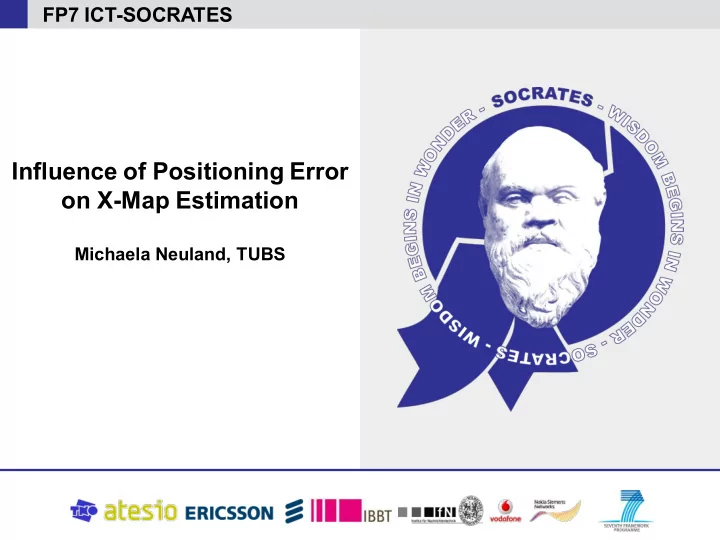

FP7 ICT-SOCRATES Influence of Positioning Error on X-Map Estimation Michaela Neuland, TUBS
Outline Motivation X-map estimation approach Simulation scenario Comparison of different X-maps Position error modelling Conclusion and next steps WWW.FP7-SOCRATES.EU 2/13
Motivation Drive/walk tests are used for radio network planning and optimisation today – expensive – cover only a limited part of the network – capture only a snapshot in time ⇒ use mobiles as probes for the service quality X-map estimation function – continuously monitors the network – estimates the spatial characteristics of the network, e.g., coverage or throughput – connects the UE measurements to an estimated geographic position – may use other sources of information, e.g. prediction data X-map is a geographic map with overlay performance information depending on – the positioning accuracy – the UE measurement accuracy – the number of measurements taken WWW.FP7-SOCRATES.EU 3/13
X-map estimation approach Propagation Model X-map X-Map Prediction Data Estimation Propagation Model Bin Update Calibration UE/RAN Measurement, Time, Position UE Location and RAN Measurement Unit Measurement Unit (LMU) (RMU) Measurement, Time, approach 1: approach 2: Location Data UE n UE 1 WWW.FP7-SOCRATES.EU 4/13
X-maps based on approach 1 (x,y) (x,y) (x,y) (x,y) (x,y) RSRP RSRP RSRP RSRP RSRP (x,y) RSRP (x,y) RSRP RSRP RSRP RSRP RSRP RSRP RSRP RSRP RSRP (x,y) RSRP + very accurate - RSRP values only for those pixels which are covered by a UE WWW.FP7-SOCRATES.EU 5/13
X-maps based on approach 2 (x,y) (x,y) (x,y) (x,y) (x,y) RSRP RSRP RSRP RSRP RSRP (x,y) RSRP (x,y) RSRP RSRP RSRP RSRP RSRP RSRP RSRP RSRP RSRP (x,y) RSRP diff diff diff diff diff diff diff diff natural water- building streets railway areas ways corr corr corr corr corr + RSRP value for every pixel in the X-map - less accurate WWW.FP7-SOCRATES.EU 6/13
Simulation scenario city area of 1.5 km x 1.5 km in Germany 20 mobile users traces derived with the help of SUMO network information available (site location, sector orientation, tilt) realistic path loss predictions at 2.6 GHz – used for determining 30 strongest cells for each user position – reference for determining accuracy of the Source: Google Earth 5.0 X-maps satellite orbits for a specific day and time WWW.FP7-SOCRATES.EU 7/13
Comparison of different X-maps (real position) approach 1 approach 2 approach 1 approach 2 µ σ µ σ 0.0 0.2 2.1 6.6 WWW.FP7-SOCRATES.EU 8/13
Position Error Modelling For LTE, three different localisation methods are foreseen – Assisted Global Positioning System (A-GPS) – Observed Time Difference of Arrival (OTDOA) – Enhanced cell ID positioning method Model for the minimum mean square position error based on the Cramér- Rao lower bound found in the literature* This model is based on the – geometry of eNodeBs / satellites and the UE – number of measured signals – standard deviation of the measurement error * C. Fritsche and A. Klein, “Cramér-Rao Lower Bounds for Hybrid Localization of Mobile Terminals”, 5th Workshop on Positioning, Navigation and Communication (WPNC ‘08), March 2008 WWW.FP7-SOCRATES.EU 9/13
Position error modelling GPS OTDOA OTDOA6 1200 3000 2000 1000 2500 1500 800 2000 histogram 600 1500 1000 400 1000 500 200 500 0 0 0 0 2 4 6 8 10 12 -1 0 1 2 3 4 -1 0 1 2 3 4 5 6 number of visible satellites number of hearable eNodeBs number of hearable eNodeBs For OTDOA measurements from at least 3 eNodeBs are necessary To improve hearability – special positioning reference signals (PRS) with frequency reuse of 6 – low interference subframes ⇒ modelled by excluding the 6 strongest cells from interference calculation WWW.FP7-SOCRATES.EU 10/13
Position error modelling GPS OTDOA OTDOA6 1200 3000 2000 1000 2500 1500 800 2000 histogram 600 1500 1000 400 1000 500 200 500 0 0 0 0 2 4 6 8 10 12 -1 0 1 2 3 4 -1 0 1 2 3 4 5 6 number of visible satellites number of hearable eNodeBs number of hearable eNodeBs 1 cumulative distribution function 0.8 GPS OTDOA6 GPS+OTDOA6 valid positions 77.1 % 66.4 % 90.6 % 0.6 mean error 8.3 m 16.3 m 8.8 m 0.4 standard deviation 6.7 m 31.4 m 6.7 m GPS 0.2 OTDOA6 0 0 20 40 60 80 100 position error in m WWW.FP7-SOCRATES.EU 11/13
Comparison of X-maps with different positioning methods GPS GPS+OTDOA6 OTDOA6 approach 1 approach 2 µ σ µ σ GPS 0.1 2.3 2.6 6.6 GPS+OTDOA6 0.0 2.3 2.9 6.7 OTDOA6 0.0 4.6 4.6 6.7 WWW.FP7-SOCRATES.EU 12/13
Conclusion and next steps Two approaches for creating X-maps have been introduced Influence of the positioning error on the accuracy of the X-maps has been analysed – approach 1 strongly depends on the accuracy of the positioning method – approach 2 is almost independent of the used positioning method Next steps: – consider other factors which have an influence on the accuracy of the X-maps – UE inaccuracies – number of measurements taken – consider real measurement data WWW.FP7-SOCRATES.EU 13/13
Thank you! WWW.FP7-SOCRATES.EU 14/13
Recommend
More recommend